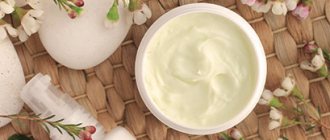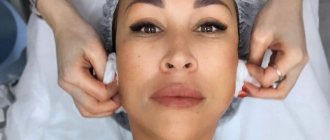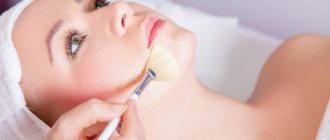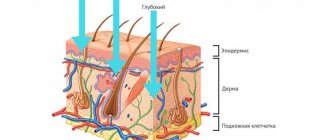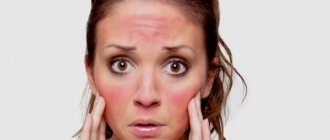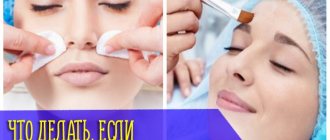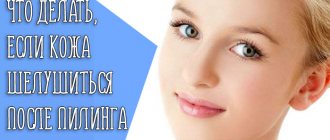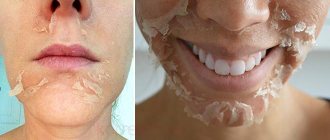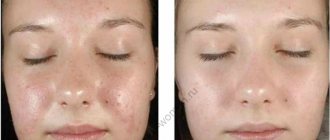Almost every girl and woman is constantly fighting for the beauty and youth of her skin. And, of course, there are plenty of problems. As in the joke: “Before the pimples had time to go away, wrinkles appeared.”
Peeling is considered the best remedy for solving most skin problems. There are different types, it all depends on what result you expect. Peeling procedures are very helpful for acne and excess oily skin. They are also quite actively used as a rejuvenating method. Most of all there are good and laudatory responses about this procedure, but there are also plenty of “horror stories”. Beginners are scared by exactly what their face looks like after peeling.
Medium facial peeling
Medium peeling affects the surface layer of the skin and partially affects the epidermis. It does not remove rough scars of various origins or facial wrinkles, but is excellent for removing age spots, skin redness, and enlarged facial pores. Body peeling is done to remove marks from stretch marks and smooth out small scars on the skin and acne marks.
This type of peeling is most often used for the face. Medium facial peeling is carried out with compounds containing trichloroacetic acid and salicylic acid no more than once every 3 months, and for a long-term effect, peeling should be combined with facial skin care programs. As a result, the skin receives a powerful lifting effect, peeling helps to get rid of abundant black, clogged pores, deep wrinkles, and age spots. Medium facial peeling helps restore complexion, tightens the skin, and in some cases helps against dark spots around the eyes.
Beauty guide: chemical peels - who are they and who needs them?
Chemical peeling is a procedure that is loved by both doctors and patients. What types of peelings are there and do you really need them? We have compiled a detailed guide for you.
Chemical peeling is a controlled damage to the skin, in response to which regeneration processes are launched. The idea is not new. In Ancient Egypt, sour cream rich in lactic acid was applied to the face. French women rubbed their skin with old wine containing tartaric acid. Nowadays, chemical peeling is one of the most popular procedures. According to research by the ISAPS Aesthetic Society in 2018, peeling was among the top 5 most popular procedures in the United States (after Botox and hyaluronic acid injections).
This popularity is facilitated by the low cost of the procedure, because it requires very little: an acid solution, sponges, sponges, brushes, a timer and a little time.
The second (and main) reason is a noticeable cosmetic effect. The skin becomes more even, smooth, wrinkles are reduced, pigmentation and acne spots are lightened, comedones are removed, and pores are reduced. The possibilities of peeling are not limited to just the aesthetic effect. The method is used in the treatment of acne, rosacea and other diseases.
Who needs it and when to start?
The ability to regenerate is the most important property of the skin, without which it could not protect the body from the external environment. In addition to regeneration associated with external damage, renewal processes are ongoing. “If the skin were not renewed, but only grew larger all the time, we would have long ago become like armadillos,” jokes Ekaterina Vladimirovna Miladinova , cosmetologist at the Petrovka Beauty clinic.
However, the mechanism of renewal of the stratum corneum of the skin slows down over time. There are many reasons. On the one hand, this process is inherent in our genes, on the other hand, it is influenced by age and lifestyle - stress, lack of sleep, poor diet, smoking.
Ekaterina Vladimirovna says: “In cosmetology there is a conventional scale of must-haves in care for different ages. At 20 years old, healthy skin has enough sun protection and antioxidants. At 30, moisturizing and exfoliation are added to these two points. At 40, you will additionally need peptides and retinoids. It turns out that by about 30 – 30+, the processes of natural cell exfoliation begin to slow down, and they should begin to be helped.”
Types of Chemical Peels
Peels are usually classified according to the depth of penetration into the skin:
- very superficial - on the very surface of the stratum corneum (exfoliation);
- superficial - acts in the stratum corneum of the epidermis and reaches the papillary layer;
- median - acts in the papillary layer;
- deep - reaches the middle of the reticular layer of the dermis.
Chemical peels are performed with acids. Depending on the type, concentration and pH, some can penetrate deeper, while others work only on the surface. For example, glycolic acid in a concentration of up to 3% is used to treat dermatoses, from 10 to 15% for superficial peels, and more than 25% for superficial-medium and median peels.
pH is an indicator of acidity: the lower it is, the deeper and faster the peel penetrates the skin. It is based on pH that products are divided into home and professional. So, for example, a glycolic peel with a concentration of 30% for professional use will have a pH of 1.8, and for home use - 3 or more. Therefore, if you see a home remedy with a high acid content, most likely its pH will be so high that you cannot harm yourself with it.
The greater the depth of the peeling, the stronger the effect, but also the higher the risk of complications. The rehabilitation period also increases. If regeneration after peeling is successful, the skin will look smoother, firmer, denser and younger. However, after too much damage, scars, hyperpigmentation, redness, or infectious complications may occur.
Home peeling
All kinds of masks, peeling pads (pads soaked in a composition with acid), scrubs combining polishing particles and acids, serums, tonics with acids - all these products act in the very top layers of the skin. They are able to exfoliate 1-2 layers of keratinized cells (out of 12-14).
Cosmetologists recommend using home peelings 1-2 times a week - this will be enough to simply maintain good skin condition. If you want some larger, qualitative changes or need to solve a problem like pigmentation or acne, then you should go to a cosmetologist.
Superficial peeling
A simple and easy procedure performed in the clinic. It is usually easily tolerated and has a good clinical effect. Suitable for, on the one hand, introducing the patient to acids, and on the other hand, so that the doctor gets to know the patient’s skin better and can predict the reaction to acids.
Ekaterina Vladimirovna : “If an unfamiliar patient comes to me, I try to play it safe as much as possible - I suggest doing almond peeling, it is one of the softest. And I start the procedure itself with a light acid wash - so that I can immediately notice if the patient experiences irritation.”
The main thing that superficial peeling does is exfoliate dead particles. It also gives cells a signal to renew - a sharp decrease in the thickness of the stratum corneum is stress for the skin, which causes increased lipid synthesis. Depending on the concentration, pH and type of acid, peelings work at different depths, but still remain within the stratum corneum.
With the help of superficial peels, you can even out texture and tone, lighten pigmentation, reduce fine wrinkles, clean and tighten pores, and prepare the skin for more serious cosmetic effects (for example, deeper peels).
Process: The entire procedure takes less than an hour. The face is cleansed and a peeling composition is applied. Then, depending on the acid, they either wash it off or send the patient home to wash off the composition after a few hours (yellow peeling). The procedure itself is comfortable - you may feel a slight burning or tingling sensation, which quickly passes.
Rehabilitation is fast: 1-3-5 days. Superficial peels do not provide strict rehabilitation - the skin after them may peel off, severely or barely noticeably (depending on the acid and the characteristics of the body). That’s why it’s also called a weekend procedure: if done in the middle of the week, then the peak of peeling will occur just on the weekend, and by Monday the face will return to its proper form.
What else you need to know before you go to a cosmetologist
One procedure is most likely not enough to see the result - you will need a course of 5-7 with a break of a week and a half.
Immediately after peeling, the skin should be allowed to work on its own - the renewal process has just started in it, there is no need to help it. To do this, you will have to give up thick creams for a couple of days.
Medium peeling
The purpose of medium peeling is to intensively traumatize the skin. It serves as an impetus for active cell regeneration, synthesis of collagen, elastin, and hyaluronic acid in tissues. As a result of the course of procedures, the oval is tightened, wrinkles and post-acne scars are reduced, and hyperpigmentation goes away.
For medium peeling, acids are used in higher concentrations than for superficial peeling. For example, glycolic 70%, trichloroacetic 35-50%.
Mechanism: acid molecules are smaller, they penetrate deeper into the skin and work not only on the surface layer, but also at the dermis level - with living cells.
Process: may be painful, the doctor may suggest taking painkillers.
Rehabilitation is not quick: for about 5-10 days the skin will peel off severely, as if you were sunburned. In the first days after the procedure, there may be swelling and redness.
What else you need to know
- Going to a cosmetologist and doing a medium peel right away will most likely not work. The procedure requires skin preparation: superficial peeling is done 4-6 weeks in advance, then products with acids are introduced into home care.
- You should never comb the skin after the procedure or pick out peelings due to the risk of post-traumatic pigmentation.
- The most common complication is the development of hyperpigmentation in those who do not use high-protection sunscreens after the procedure.
Deep peelings
Deep peelings are almost never done now. During the procedure, almost all layers of the dermis are removed, leaving only small islands of tissue. This is practically an operation performed by plastic surgeons under local anesthesia. Deep peelings are carried out with TCA or phenol-based compounds.
It is impossible to predict how the skin will recover after such damage. The regeneration process is very painful and long - up to 6 months, there is a risk of post-inflammatory pigmentation, problems with blood vessels and even skin tone. In fact, the body grows new skin.
However, there is still a demand for the procedure. If healing is successful, even deep wrinkles and age spots will disappear, and the skin will noticeably tighten. The effect of such peeling lasts 10-15 years.
Ekaterina Vladimirovna : “With the advent of lasers, many clinics abandoned deep peelings. Because in order to work in the deep layers of the skin with peeling, you need to damage the upper layers, and this is a lot of risks during healing. The principle of laser operation is completely different - its wave can penetrate deep without damaging the upper layers. The skin remains protected by the stratum corneum, which means it recovers normally.”
The main acids used for peelings
The main active ingredient in chemical peeling is acid. Their main task is to exfoliate. But depending on the type, they also have other positive effects.
AHA acids (Alpha Hydroxy Acids) are obtained from plants, fruits, milk or synthesized artificially. This:
Almond is a large molecule that cannot penetrate deep into the skin and remains in the superficial stratum corneum. Therefore, this peeling is one of the mildest, does not cause irritation, and is easily tolerated by patients.
It reduces fine wrinkles, improves skin texture, and removes post-inflammatory and hyperpigmentation. It is especially indicated for patients with a combination of photoaging and acne, as well as for acne rosacea.
Glycolic acid - this acid has the smallest molecule, so it penetrates the skin easily and quickly. However, for the same reason, peeling can cause burning, stinging, and irritation, especially for sensitive skin. Pros: moisturizes because it can hold water molecules around it; promotes exfoliation, destroying connections between dead cells of the stratum corneum (corneocytes), reduces fine wrinkles.
Milk - moisturizes and exfoliates. The skin becomes smoother and fuller. Best suited for aged and dry skin. Under its influence, the edges of pigment spots fade, and the overall tone becomes smoother. Therefore, it is especially good for aging skin with pigmentation.
Other AHA acids: acetic, malic, citric, tartaric and others.
BHA acids (Beta Hydroxy Acid) are fat soluble, not water soluble. There are several BHA acids, but salicylic acid is usually used in cosmetology. It is able to dissolve in sebum, prevent the appearance of comedones and remove blackheads. It has a powerful anti-inflammatory and antiseptic effect, but does not penetrate into the deeper layers and causes virtually no side effects. Peels based on pure salicylic acid are recommended for patients with acne, seborrhea, hyperpigmentation, wrinkles, and skin microrelief disorders.
Due to its ability to “loose” the stratum corneum, salicylic acid is often used in other chemical peel protocols (for example, retinoic peels) to improve their penetration and achieve a more pronounced result.
And also
Trichloroacetic acid (TCA) - especially indicated for superficial wrinkles. Provides renewal of the epidermis, stimulates metabolic processes, helps improve skin texture, as well as various types of scars (post-traumatic, post-operative, post-acne) and other skin relief disorders.
Jessner's solution is a combination of resorcinol and lactic and salicylic acids. The solution is applied in layers - the more layers, the deeper the peeling will penetrate. This allows the doctor to individually select the number of layers - from 1 to 8 - for each specific patient, thus achieving the optimal result. Peeling causes active peeling, making it effective for hyperkeratosis, pronounced age-related changes and skin texture disorders.
Retinoic or yellow peeling stands apart . The mechanism of its action is fundamentally different from the action of other acids: the composition works in the surface layer and does not damage living cells, but stimulates cell renewal in deeper layers. As a result, skin aging slows down, its texture and density improves, and its texture and tone are evened out.
Some cosmetic brands produce cocktails - mixtures of different acids. However, there is a small risk in this - if the skin was not familiar with acids before, it may react, and it will be difficult to figure out what exactly. Therefore, many cosmetologists prefer mono-peelings.
Contraindications
- Active viral, fungal, bacterial diseases. Open wounds. Previous dermatitis (psoriasis, atopic dermatitis).
- Previously used products with photosensitizing effects.
- For medium and deep peels - impaired scarring of skin tissue, keloids, use of isotretinoin in the last 6 months.
The most common questions to the doctor and answers to them
Is it possible to remove pores?
Ekaterina Vladimirovna: Over time, the mouths of the pores stretch, so the older the person, the larger the pores. You can clean the pore with peeling and it will tighten a little. But it’s impossible to completely remove it and make the skin perfectly smooth. Even with a laser. You may achieve some short-term effect, but eventually they will appear again.
What is better - peeling or laser?
Ekaterina Vladimirovna: Peels do an excellent job with all the imperfections in the upper layers of the skin - small wrinkles, uneven tone, fresh pigmentation. But with large defects - scars, hyperpigmentation, deep wrinkles - it is better to go for laser.
At the same time, my patients are very different. Some people prefer to do a peeling course - it’s painless, the rehabilitation is almost invisible, you don’t fall out of life, you just need to go to the clinic 4-7 times. Others prefer lasers. They allow you to reach the deeper layers of the skin, but the rehabilitation process is longer, crusts do not form, but swelling and redness last longer. Although, of course, everything depends on the aggressiveness of the procedure, whether it is peeling or laser damage (usually fractional photothermolysis). The laser is also done repeatedly.
And now it’s popular to combine laser resurfacing and surface peeling, because everyone is always in a hurry and wants to immediately “make me beautiful,” so there are methods here too.
Is it possible to do peeling in the summer?
Ekaterina Vladimirovna: There is an opinion that chemical peelings are impossible during periods of high solar activity. However, this mainly applies to medium and deep peels and those patients whose skin is prone to hyperpigmentation. Otherwise, with properly selected home remedies (including sunscreens), peelings can be performed.
We thank the Petrovka-Beauty clinic and personally the director Natalya Buzhinskaya and cosmetologist Ekaterina Miladinova for their help in creating the material.
Medium peeling photo
Description of the procedure
Before the first procedure, pre-peeling preparation of the skin is necessary. The procedure itself lasts from 15 to 60 minutes, the duration depends on the sensitivity of the skin and the thickness of its stratum corneum, as well as on oiliness.
Before moving on to peeling, the cosmetologist, if necessary, anesthetizes the skin or gives the patient a sedative, then special cosmetics are applied to the skin. After the acid penetrates the desired level of the epidermis and affects the skin, the chemical composition is neutralized with dry ice. After approximately 45 minutes, the redness of the skin disappears and it returns to its usual color. At the end of the procedure, the cosmetologist applies cream to saturate the skin with a greasy composition.
Retinoic yellow peeling: indications and contraindications
Indications
for the use of retinoic yellow peeling:
- The appearance of small wrinkles;
- Heavy pigmentation caused by long exposure to the sun;
- Loss of elasticity and firmness;
- Insufficient collagen production;
- Acne;
- Skin aging;
- Insufficient skin hydration;
- Hyperkeratosis;
- Need for bleaching;
- Hyperpigmentation.
The retino yellow peel also has several other benefits. It has a lifting effect, gives the skin a smoother appearance and improves relief, removes any impurities from the surface, and stimulates anti-inflammatory processes. The external condition of the skin improves and a healthy glow appears.
Contraindications
for the use of retinoic yellow peeling:
- Allergic reactions that may be caused by the use of retinol;
- Incompatibility with other medications: this peeling can only be done six months after taking Roaccutane.
- The presence of viral infections, which, together with retinoids, can cause a herpes rash;
- Liver disease, as well as previous hepatitis;
- Increased skin sensitivity, which may be indicated by problems such as atopic skin reactions, seborrheic dermatitis, eczema;
- Photosensitivity – high sensitivity to solar or other radiation with a UV component;
- Pregnancy and planning in the coming year, as well as the lactation period;
- Presence of warts.
Skin care after peeling
After completing the peeling, you need to take care of your skin: wash your face twice a day and apply a special healing cream.
During the week, it is not recommended to remove the crust from the face on your own (detachment of dead cells), otherwise a scar may remain in this place; scratching and using scrubbing agents is also prohibited. Because it is during this period that a new, young layer of skin is formed under the crust.
In another week, young skin will become dense enough and you can return to your previous rhythm of life, refreshed and rejuvenated. In the future, to maintain the effect, you can carry out the procedure once every six months, and sometimes once a year.
We must not forget that the procedure for medium facial peeling is best done in a trusted place by an experienced specialist. Medical will help make your skin perfect and rid your face of unnecessary defects with the help of medium peeling. Our professional cosmetologists will help you choose cosmetics that are suitable specifically for your skin and will carry out the procedure in compliance with all the rules to achieve maximum effect.
Central Scientific Research Institute of Dermatology and Venereology of the Ministry of Health of Russia.Specialization Dermatovenerology. Cosmetology. Education - Moscow State Medical and Dental University.
Moscow Medical Academy named after Sechenov.
Special Skills - Therapeutic cosmetology
- hardware cosmetology (face and body)
- injection methods in cosmetology (mesotherapy for the face and body, mesotherapy for the scalp)
- biorevitalization
- contour plastic surgery with preparations based on hyaluronic acid (Juvederm, Perfect, etc.)
- use of 3D threads
- various types of chemical peels (salicylic, TCA, glycolic, yellow, etc.)
various types of hair removal laser cosmetology (removal of stretch marks, scars, pigmentation, etc.) facial and body treatments using cosmeceuticals from various companies
Clinic - st. Myasnitskaya, 24/7, building 1, Chistye Prudy metro station, Turgenevskaya
- Beskudnikovsky Boulevard, 6, bldg. 3, metro station Verkhniye Likhobory
Work experience Over 18 years PROFILESchedule
Central Scientific Research Institute of Dermatology and Venereology of the Ministry of Health of Russia.
Specialization Dermatovenerology. Cosmetology. Education - Moscow State Medical and Dental University.
Special Skills - hardware and physiotherapeutic methods in cosmetology (face and body)
- injection methods in cosmetology (mesotherapy for the face, body, scalp)
- contour plastic surgery with preparations based on hyaluronic acid (Juvederm, Restylane, etc.)
- biorevitalization
- various types of hair removal
- use of 3D threads (thread lifting)
- various types of chemical peels (salicylic, TCA, glycolic, yellow, etc.)
laser cosmetology (laser resurfacing of the face and body, removal of tumors (papillomas, warts, etc.), removal of stretch marks, pigmentation)
Clinic - st. Myasnitskaya, 24/7, building 1, Chistye Prudy metro station, Turgenevskaya
- Beskudnikovsky Boulevard, 6, bldg. 3, metro station Verkhniye Likhobory
Work experience More than 14 years PROFILESchedule
Recommended Doctors
Elena Valentinovna Bochkareva
Cosmetologist
Injection methods of rejuvenation, contouring, thread lifting, laser rejuvenation, hair removal, hardware methods for body correction and age-related changes in the face.
Anna Vladimirovna Dyachenkova
How to prepare for the procedure
The preliminary stage requires the following basic steps to be carried out sequentially: diagnosis and history taking, skin examination, conversation with the patient, informed consent and pre-peel preparation.
Let's look at each stage separately. When a client first comes to the doctor and says that he wants to undergo the retino yellow peeling procedure, he is scheduled for an examination, during which his skin type is determined and his general condition is analyzed. The conclusion should contain such items as the presence of scars, elastosis, inflammation, signs of photoaging, and pigmentation disorders.
The doctor creates a patient record, which includes photographs reflecting the appearance of the skin before peeling. The signed informed consent is also included there. The medical history includes information about the sun exposure regimen recommended for the client during the preparatory period.
The doctor needs to find out how the patient took care of his skin. He should be asked the following questions:
- Has the client ever tried self-peeling using retinols and what was the skin reaction?
- What diseases was the patient being treated for?
- Do you have any allergies?
- Did you have diseases such as seborrheic dermatitis, eczema, rosacea?
- Have there been any cases of viral hepatitis or other liver problems?
- About pregnancy or planning a child in the near future. If the answer is yes, then peeling cannot be done.
- Are there any warts on the areas of the skin where the retinoid mask will be applied?
- Are there any signs of skin photosensitivity? If so, the patient must be careful to avoid contact with sources of UV radiation (the sun, various lamps, solariums or other artificial tanning facilities).
During the first examination, you need to thoroughly clean the skin and carefully examine. Using a magnifying glass, the doctor looks for signs of diseases on the skin for which the retino yellow peeling procedure cannot be performed. These are viral warts, herpes, molluscum contagiosum. Skin color is assessed and its type is determined.
The next stage is a conversation with the patient. The client talks about the results he wants to achieve. This could be getting rid of fine wrinkles, removing age spots or scars, reducing pores, overcoming roughness, acquiring a brighter skin color or lightening it. The patient is also shown photographs of other people who have already undergone this procedure. The client talks about whether he is satisfied with everything and whether he wants to achieve the same results.
Next, in accordance with the wishes of the patient, the doctor designates those areas of the skin that will be subject to application of a mask with retinoids. The doctor is obliged to inform the person about what the recovery period will be after the procedure, so that the client knows that his skin will probably return to its normal appearance within two weeks, that it will first peel off a lot, then turn red and become more sensitive. Depending on the results that the patient needs, the doctor may recommend a course of several sessions of retinoic yellow peeling.
If the client is satisfied with everything and agrees to the procedure, informed consent is read out to him on a voluntary basis. He signs two copies: one for himself, the second for the institution. Such documents are needed to avoid possible conflict situations in the future.
Next, the skin begins to prepare for peeling. In patients with normal skin type, this process takes about two weeks. Dark-skinned people need four weeks to determine the safe interval for using products with retinoids, since this type of epidermis has an increased sensitivity to the effects of such drugs.
A very good preparation for the skin would be to use cosmetic products containing retinoids (0.025-0.1% tretinoin) at home.
Mechanism of action. What drugs are used?
The principle of the procedure is simple - the chemical damages the epidermis. After this, the skin cells activate their forces and direct them to enhanced renewal of the skin. Fibroblasts begin to be produced, which, in turn, cause the formation of collagen, elastin and other useful substances. This leads to hydration and thickening of the epidermis.
The cosmetologist selects peeling products individually depending on existing skin problems.
| Basic acid | Type of peeling | Brand of drug |
| Fruit and glycolic | Surface | Jan Marini, LA Peel, MD Forte, Agera RX, Cosmedix |
| Retinoic | Surface | Mene and Moy System, Mediderma |
| Trichloroacetic | Median | Skintech Peel, Compositum, Obagi Blue Peel, Cosmedix |
| Carbolic (phenol) | Deep | MC Peel, Green mask |
Professional peelings: mechanism of action
The skin of the face is thin and delicate. It is most susceptible to the influence of adverse weather factors and ecology, which trigger age-related changes. Therefore, it is so important to provide proper care and prevent early withering and aging processes. The use of nourishing and moisturizing masks and creams benefits the skin, but it cannot trigger active cell renewal and regeneration. This effect is achieved by a more radical procedure – exfoliation (peeling) of the dermis.
The essence of the method is to remove the top, keratinized cells and cleanse the facial skin. During the cleaning process, intensive exfoliation of the stratum corneum occurs, which stimulates deeper cells to actively regenerate. Their accelerated division helps to heal and rejuvenate the epidermis, even out the tone, and eliminate minor defects. Young skin, freed from dead cells, intensively absorbs and absorbs nutrients, moisture and oxygen.
As a result, the cell renewal mechanism is launched, metabolic processes are activated, and the synthesis of collagen and elastin fibers is improved. This is necessary to maintain facial skin turgor and slow down the aging process.
Contraindications
- pregnancy, lactation period;
- intolerance to the components included in the peeling;
- very sensitive skin prone to allergic reactions;
- open wounds, abrasions, scratches, rash of unknown origin in the area of the face where it is planned to cleanse;
- the patient after surgery, in a weakened state, during the period of an infectious disease, with high temperature and fever;
- herpes during relapse.
Each type of peeling has both its advantages and disadvantages, each has indications and contraindications.
The patient will not have difficulty choosing a cleansing procedure if he consults a cosmetologist.
Only after consultation, the doctor will be able to choose a cleansing method in accordance with the skin type, its flaws, and solve all problems.
How can the incidence of complications be reduced?
To protect yourself from complications caused by professional illiteracy, ask the cosmetologist to provide documents on education and permission to engage in this activity. Make sure that there are quality certificates for the drugs that will be used during the procedure.
The positive outcome of the peeling will largely depend on you. Strictly follow all specialist recommendations. This applies to both the preparation procedure and the care of treated skin. Do not hide the presence of contraindications from the cosmetologist.
Skin preparation
- Superficial peeling.
If there is a herpes virus in the body, then preventive measures are taken to prevent its manifestation. If a drying acid is to be used, skin moisturizers are prescribed.
To determine the tolerability of the composition and gradually get used to it, you will need to regularly apply pre-peeling agents or acid to the skin, which will be used for peeling, but in a lower concentration.
Not all chemical compounds can successfully penetrate the skin. In this case, a few days before the procedure, degreasing lotions begin to be used. During preparation, some restrictions are observed - it is forbidden to go to the pool, solarium and use certain medications.
- Medium peeling.
With this method of exposure, the same preparation methods are appropriate as for superficial peeling, but with some additions. A few days before the procedure, peeling with glycolic acid is done. After it, the skin is lubricated daily with creams containing fruit acids.
Skin contact with ultraviolet rays should be completely excluded. For this, the cosmetologist will select a suitable sunscreen. The use of scrubs, washcloths, and rough sponges is prohibited. You will have to give up hair removal and eyebrow correction for a while. This will protect the skin from damage. If indicated, a specialist may prescribe medications to strengthen the walls of blood vessels.
- Deep peeling.
The main task of preparing for this type of chemical peeling is to exclude any types of complications. The body is carefully examined, special attention is paid to the kidneys, liver and heart. Antioxidants and medications are taken to increase the strength of the walls of blood vessels. Six months before the procedure, stop taking retinoids.
The skin is treated with whitening compounds to protect against hyperpigmentation. 90 days before deep peeling, it is forbidden to go to a solarium or be in the sun. Within 10 days, procedures that can cause skin damage are stopped.
Possible complications and side effects
Chemical peeling is damage to the skin, which, one way or another, is accompanied by unpleasant consequences. They are divided into expected, which are a natural reaction of the body, and unexpected. The first type includes:
- swelling;
- redness;
- burning;
- peeling;
- tightness.
Swelling usually occurs due to allergies, impaired fluid outflow or interruptions in the functioning of blood vessels. It should go away within 24 hours. Redness after peeling is always observed; if it is not there, this indicates the ineffectiveness of the procedure. The burning sensation occurs from the action of acids on the cells of the epidermis. It may occur during application of the drug and persist for 24 hours.
The intensity of peeling depends on the type of peeling. With superficial skin, finely scaly skin discharges are observed, and with other types it peels off in whole layers. The feeling of tightness is formed due to sudden dehydration of the surface. It may last for several days.
Unforeseen complications after chemical peeling include the following:
- recurrent herpes;
- allergic reaction;
- tissue infection;
- severe inflammation;
- persistent redness of the surface;
- hyperpigmentation;
- seborrhea;
- increased skin sensitivity;
- demarcation line;
- acne and follicles;
- telangiectasia.
Stages of the procedure
- Step 1. First, the cosmetologist will carry out cleansing activities using milk or gel. Afterwards, disinfectant and degreasing compounds will be applied to your skin. Additionally, it will be treated with a pre-peeling agent, which will level the surface and improve permeability.
- Step 2. Starting from the forehead and moving to the chin, the specialist will apply the prepared preparation to the face in an even layer. If necessary, the manipulation will be repeated.
- Step 3. When the exposure time has expired, the dermis is lubricated with a neuralizer. After this, it will be removed along with the acid. After removing all the ingredients, a product will be applied to your face to soothe and moisturize your skin.
How to choose a peel for your skin
When deciding which cleaning method to choose, focus on the following parameters:
- Your skin type: oily, dry, normal;
- Problems that need to be resolved;
- Contraindications to the procedure;
- The cost of a specific method;
- What does this type of facial peeling provide?
- How will facial peeling be carried out by a cosmetologist?
It is best to choose a specific method together with a cosmetologist. A professional will help you figure out which type of cleansing is best for your skin, and which types you should avoid for your indications. The specialist will also introduce you to the drugs on which the procedure will be carried out and provide information on prices.
Why is it better to have the procedure done by a cosmetologist, and how often should it be done?
Salon facial peeling - removal of dead keratinized epidermal cells from the surface of the face. But an incorrect procedure can lead to irreversible consequences:
- facial burn;
- mechanical damage to the skin;
- Too frequent, intensive procedures have the opposite effect - they accelerate aging.
You should entrust the youth and natural beauty of your skin to professionals - a cosmetologist or dermatologist with an excellent reputation and good experience.
There are many cleansing procedures, each of which can effectively solve one or more problems; professional help is required to understand them and achieve effect.
Only a specialist can choose a peeling:
- by skin type (dry, oily, combination);
- take into account its characteristics (age, general condition);
- solve problems (wrinkles, pigmentation, dull color, dryness).
Only a specialist can calculate the course of procedures and choose a cleansing method after a personal examination of the patient.
Without experience, it will be very difficult to understand all the intricacies of cleaning yourself; every mistake will be reflected (literally) on your face.
Is it worth taking such risks and experimenting with your appearance?
Selecting a peel according to the type of wrinkle
Before you undergo a chemical peel, you need to figure out which procedure is best for you. Cosmetologists have conventionally divided the skin according to the stages of aging into four main types and selected their own type of peeling for each.
| Type | Name | Description | Type of peeling |
| I | No wrinkles | Barely noticeable wrinkles, light pigmentation, no areas of skin with thickening | Surface |
| II | Wrinkles in dynamics | Folds become more noticeable when facial muscles are used, small areas of pigmentation, mild keratosis | Median |
| III | Wrinkles at rest | Wrinkles are visible in a relaxed state, pigmentation is clearly visible, keratosis is present | Median |
| IV | All wrinkles | Folds cover the entire surface of the face and do not allow the application of decorative cosmetics | Deep |

